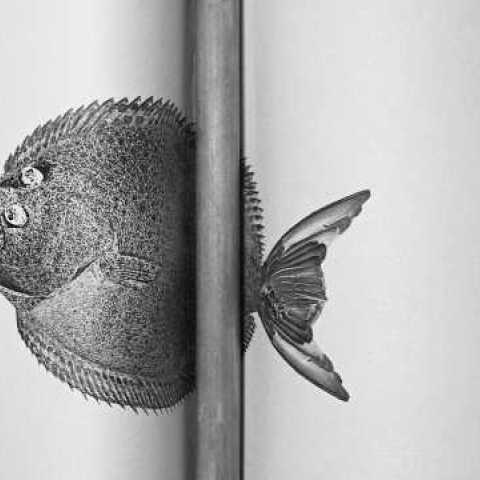Peer
99 Hoxton St
London
N1 6QL
United Kingdom

Savinder Bual’s fascination with the mechanical inventions and engineering advancements of the 18th and 19th centuries is a central concern of her work. At this time in British history, the arts and sciences were often entwined and curiosity about the world was further fuelled by discoveries made during colonial expansion. Bual is interested in early experiments in moving image making and has used a number of low-fi techniques to create the illusion of movement in real time. “I imagine myself as a cinema pioneer”, she has said.
The new film work for PEER will be a looped projection onto one of the large gallery windows, to be viewed from outside. By mechanically feeding a two-dimensional image of a flatfish through two rollers, the artist creates the illusion of three-dimensional movement, using a technique inspired by the early film experiments of the 19th century French scientist Étienne-Jules Marey.
The other new commission for PEER is a water-powered slide projector, made from wood and ceramic combining concepts from rudimentary water clock technology with basic principles of gravity and weight transference. It will be activated by a gallery assistant, and visitors will witness a short performance / demonstration where a projected image of a seascape is gradually flooded.
The title of the exhibition references another kind of exotic novelty, the South American fruit ananas, or pineapple. A staple food throughout South America, it was introduced to Europe in the 17th century and soon became an indicator of status and wealth, and part of the trappings of colonial power well into the 18th century. Bual’s nine bow-activated stringed instruments produce sound when fresh pineapple tops are spun over the strings will be installed in the gallery. The performance by The Pineapple Orchestra was at Bristol’s Colston Hall (now the Bristol Beacon) in November 2018, at a point when the venue was undergoing its name-change. Recent activist events in the city have highlighted the complexities around the civic statuary of individuals who were involved in or engineers of the slave trade. In Bual’s treatment of this subject, she proposes a provocatively playful response, and one that is open to dialogue and discourse.
About Savinder Bual
Savinder Bual (b. 1976, Hitchin, UK) has a BA in Fine Art from Winchester School of Art (1998) and an MA in Photography from The Royal College of Art London (2010). Solo exhibitions include Javasu featuring text works by Sarah Boulton, Caraboo Projects, Bristol (2019); The Drawing Center, New York (online, 2016); Pinjekan, Minories Gardens, Colchester (2015); Organism, iD TOWN, Shenzhen, China (2014); Ahmed and Carpenter Presents: Frogfullness, Rogue Project Space, Manchester (2013) and Savinder Bual Flying Works, Little Victories Gallery, Shanghai (2013). Bual has participated in numerous group exhibitions at institutions across the UK including Standpoint, London; University of the West of England, Bristol; Bow Arts, London; Legion Projects, Glasbury, Wales and Oriel Davies Gallery, Newtown, Wales. She has also taken part in a number of residencies and in 2020 was awarded a Jerwood Bursary and a-n Artist Bursary, she has also lectured and been involved in a number of talks and publications.
